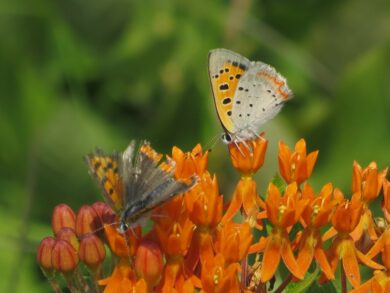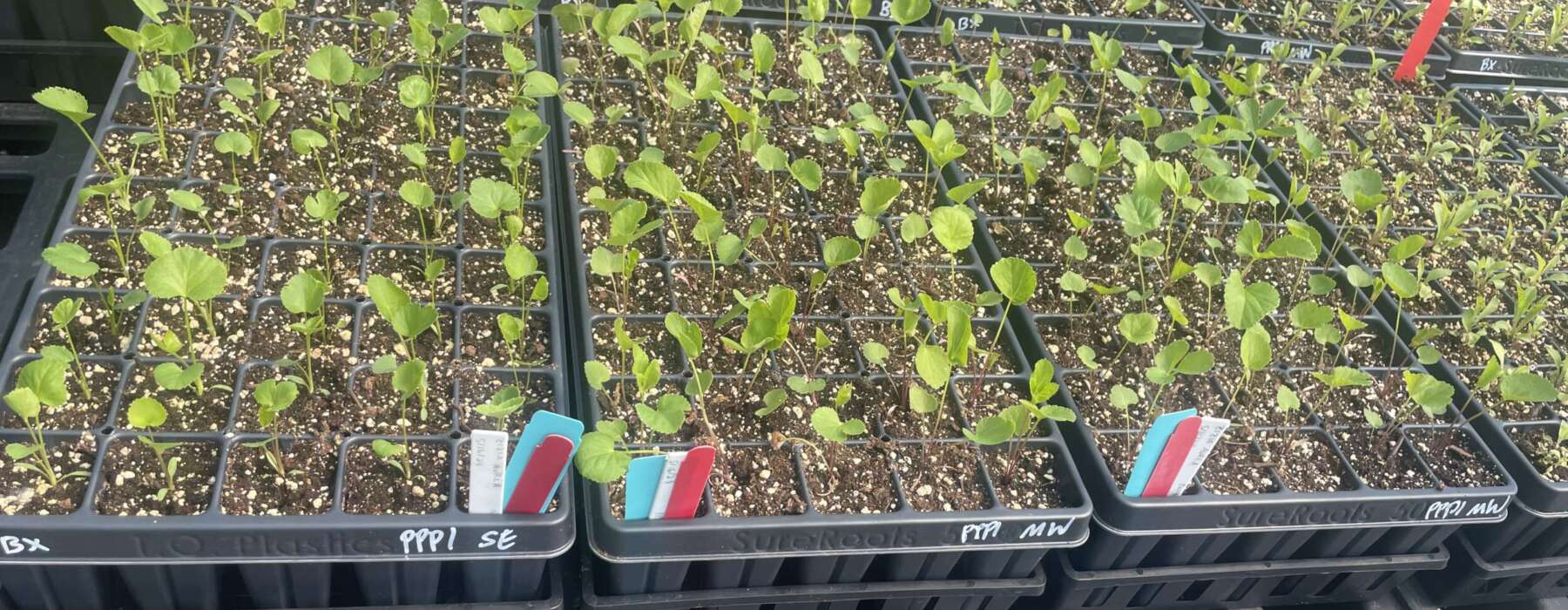During the summer and fall of 2024, the VCE plant ecotype team planted approximately 1100 perennial flowering plants in six common gardens across the Upper Valley region of Vermont and New Hampshire. These plants, sourced from three distinct ecoregions, were planted to generate data on the relationship between plant ecotypes and insect support, and resulted in a surplus of approximately 1200 individual plants.
Community scientists can help expand the scope of this experiment by adopting and planting one of our extra plants in their own gardens. By collecting data on plant growth and insect activity throughout the year, participants can help us gather more conclusive evidence on the relationship between plant ecotype and pollinator support. If you live in Vermont, New Hampshire or Massachusetts, sign up to adopt a plant!

American Copper on Asclepias tuberosa (Butterfly Milkweed)
Project Goals and Objectives
The project’s overall goals are to:
- Compare plant growth and insect use among local and non-local provenances across larger spatial scales and environmental conditions
- Engage new community scientists by providing an easy entry point to do science in their own backyard
We have recruited 700 community scientists for 2025! Stay tuned to get more information about our progress with these goals after our first season concludes.
FAQ
- What is the goal of the Adopt a Plant project? The goal of the Adopt a Plant project is to gather more conclusive evidence on the relationship between plant ecotype and pollinator support across larger spatial scales and environmental conditions.
- What locations are eligible to participate? Vermont, New Hampshire, Massachusetts.
- What are the important dates? Participants will be contacted in March/April 2025 to pick up their plants, and will be expected to collect data weekly from May – October 2025.
- Where are the pickup locations? Pickup locations are still being finalized, and we will endeavor to provide options that are 1.5 hours or less from your location. Finalized locations: White River Junction, VT; Manchester, NH; Burlington, VT; Springfield, MA; Rutland, VT; Montpelier, VT
- How do I get involved? Sign up for 2025 are currently closed. Please stay tuned for details about the 2026 season.
- Does my soil type or sun exposure matter? Yes and no. We will ask about your soil type before the experiment starts, but we will not exclude participants based on their soil type or sun exposure.
- What is provided and what are participants expected to provide? Plants (both local and non local ecotypes), tags, pollinator ID training, plant care guidelines and a data entry app will be provided to all participants. Participants should have access to a device with internet access that can download an app or access a web browser. Participants should also have space in their garden or somewhere outdoors to place the plant (e.g. container on a balcony or lawn space).
- What happens if the plant does not survive? That is not a problem! We expect that some plants might not make it due to several factors throughout the course of the experiment.
- I am a teacher, how can I include my class in this experiment? Reach out to the program coordinators at to discuss options. Also, you can learn more about and sign up for the VCE community science teacher workshop HERE.
- What happens to the plants after the experiment? Participants are welcome to keep the plants as a token of appreciation.
- I’ve signed up on the form but I haven’t been contacted yet? Please send an email to . We have contacted all confirmed participants with pick-up location options so if you have not heard from us, it is likely that we have an incorrect email address. Thank you for your interest!

